Anis de Flavigny: Bonbons in Burgundy
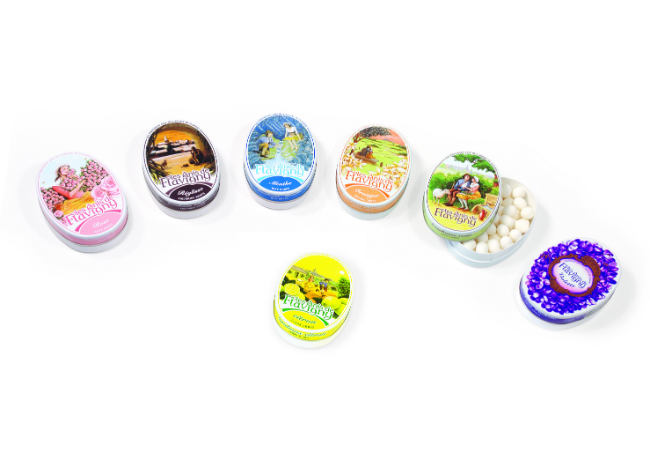

The village of Flavigny-sur-Ozerain nestles securely on a prominent hilltop overlooking the soft valleys of Burgundy’s Côte-d’Or. As one of Les Plus Beaux Villages de France, it offers all the charm, history and ambiance that you’d expect: ancient fortified stone walls and gates, medieval buildings, narrow lanes over-looked by a mélange of characterful private houses and ecclesiastical buildings. Out of season it’s quite a sleepy place – the doors are locked and the shutters closed.
As you walk up from the car park into the Rue de l’Abbaye, at first you aren’t aware of anything unusual about the village. You notice the imposing walls of the old Abbaye Saint-Pierre but this is hardly the place you’d expect to find a famous factory employing around 30 people. Yet, remarkably, Flavigny is home to la plus vieille marque de France, the country’s oldest brand. Here, with great care and affection, are made the much-loved Anis de Flavigny.
These popular little bonbons have a fascinating and impressive back-story which is inextricably linked to the history of Flavigny itself. Although today the picturesque village mainly comes to life in the summer, with an influx of holiday home owners and tourists, it once had a far nobler role to play in the fabric of Burgundian spiritual life.
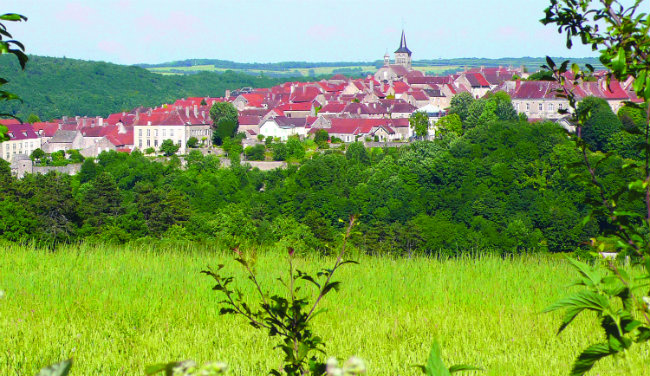
Village of Flavigny-sur-Ozerain. © Anis de Flavigny
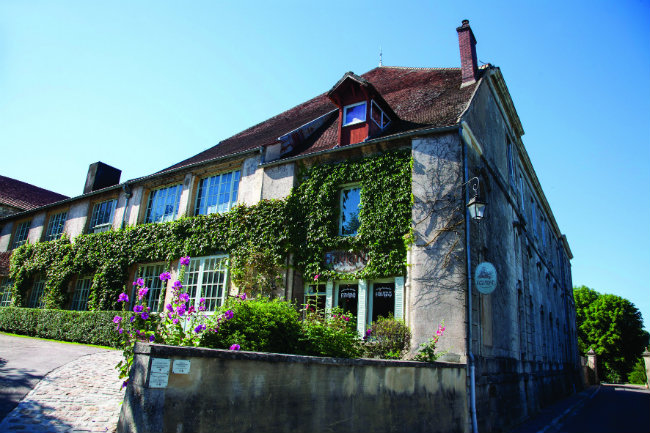
L’Abbaye des Anis de Flavigny. ©Anis de Flavigny
The 8th-century Benedictine Abbaye became a place of pilgrimage as numerous visitors came to see the holy relics of Sainte Reine, which remain in the village to this day. Over the centuries, Flavigny grew to become a thriving medieval town with fortified walls, and newly founded churches and convents.
At the heart of every Anis bonbon (or candy for our US readers) lies a tiny seed of anise. Pimpinella anisum, the plant from which the seeds are harvested, has a history which can rival the village’s own. It can be traced back to Biblical and Roman times, and was much prized for its healing and medicinal value, especially to aid digestion and intestinal disorders. It’s no surprise then that the monks of the Middle Ages would have been familiar with anise.
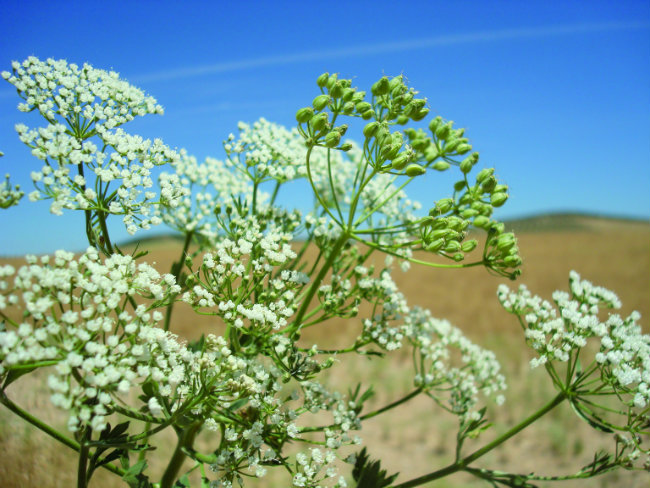
Field of flowering Anis © Marc Troubat
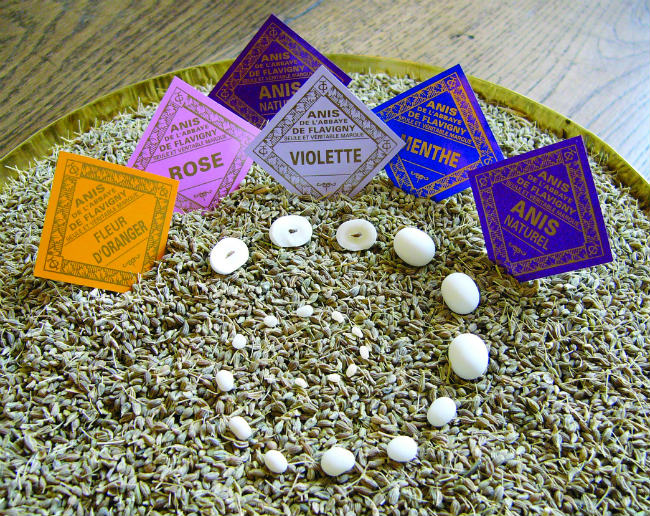
Evolution of an anis seed. ©Emmanuelle Berret
With the increasing availability of sugar, it wasn’t long before herbalists were combining these two essential elements to create a pleasant-tasting and portable treat. It proved especially popular among royalty and court nobles, and it must surely have helped the monks sweeten the passing of the long hours in those cold and draughty monastic buildings.

Jean Troubat, who brought the company’s products to the world
A Family Concern
Over the years, the labour intensive process of coating the kernels with sugar syrup was refined by confectioners – by 1814, Flavigny had no less than eight anis producers, who had taken over from the monks. The French Revolution of 1789 had seen the destruction of many of the monastery buildings and parts of the Abbaye, with just five monks remaining and much of the religious property sold off into private hands. But the confectioners survived these turbulent times, eventually merging into one company, Galimard, which was acquired by the family Troubat in 1923.
When I met the current Managing Director, Catherine Troubat, she told me how her grandfather, Jean, had been the creative inspiration behind the early branding, marketing and distribution of Anis de Flavigny.
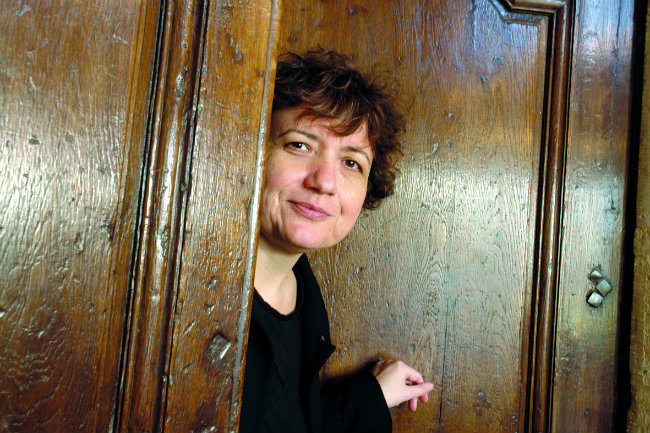
Catherine Troubat, the Managing Director ©Anis de Flavigny
She showed me some of their early marketing literature and recounted how her grandfather was always looking out for new ways to publicise and sell the sweets. When new-fangled self-service vending machines arrived on train platforms in the 1950s, Jean spotted an opportunity and quickly pioneered the now popular metal box in order to protect his sweets from their harsh mechanisms. During the Universal Exhibition of 1867, Anis de Flavigny were sold from kiosks in the Eiffel Tower’s gardens and won many awards.
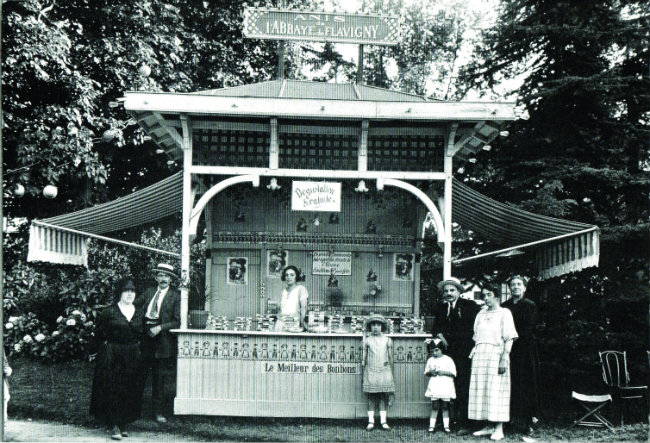
The kiosk at the 1867 Exposition Universelle in Paris ©Anis de Flavigny
Secrets of the Past
Extraordinarily, for a business selling over 200 tons of the pastilles all over the world, the entire operation is still run from a warren of interconnecting rooms and corridors within the old Abbaye Saint-Pierre.
Parts of the Abbaye destroyed during the Revolution still hide secrets of the past. In the late 1950s, the Yale archaeologist Fred Guggenheim came to Flavigny and, with the permission of Catherine Troubat’s father, began a programme of research and excavation in the grounds. Armed with an old map from 1665, they began to dig in the Troubat’s kitchen garden and eventually, under many metres of soil and rubble, succeeded in discovering the legendary Chapel of the Forty Columns, also known as the Chapel of Notre Dame. This remarkable Carolingian chapel adjoins the crypt of Sainte Reine and dates back some 1,200 years – the Emperor Charlemagne is said to have attended its founding ceremonies. The treasure trove of statuary and stone ornaments unearthed during the dig and the subsequent restorations are on display in the tasting rooms of Anis de Flavigny, providing a suitably reverential atmosphere for sweet-toothed worshippers to pay their respects and try each of the flavours!
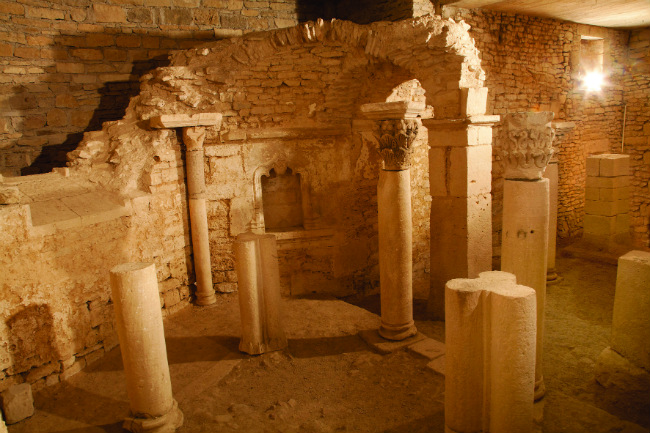
The Carolingian crypt discovered in the late 1950s. ©Anis de Flavigny
Although headquartered in an unusual and historic setting, this certainly isn’t a backward-looking business. Catherine has plans to expand into the Chinese and Asian markets and travels regularly to meet potential distributors. She recounted how she likes to conduct some very personal test marketing, offering Anis de Flavigny to cab drivers and hotel employees wherever she travels, such is her enthusiasm and determination to find new markets.
It’s evident that there’s great care and attention to detail in every aspect of the company’s work – for example, in the strict attention to hygiene in the sugar coating workshop, where it takes 15 days to build up the super smooth layers of sugar that coat each Anis. Equally, as befits France’s oldest brand, there exists tremendous pride in the design and marketing of the product, and the company keeps many examples of its early designs in its archive.

A vintage poster depicting the shepherd offering sweets. ©Anis de Flavigny
The vintage-style packaging isn’t simply a superficial design exercise, but has its roots in the traditions of candy being a demonstration of love. Thus, from the earliest illustrations emerges the charming story of the shepherd sitting in a shady bower, offering a shepherdess a token of his affection. Although illustration styles have changed over the decades, this traditional motif, on the boxes of the original anis-flavour sweets, has remained a constant.
Here is a family business that truly wants to remain loyal to their brand and its values. And it’s also a smart strategy, for this small independent business has to compete in a global market, alongside the big corporate confectionery giants and their mega-brands. The designs and the packaging of Anis de Flavigny make a powerful visual connection with the old romantic traditions of France. This appeals not only to the French market but also to a much wider audience of buyers who are seeking something genuine and original in a world of mass-production and fake ‘retro’ styling. The brand even has Facebook fan pages and, last June, opened a museum to house their memorabilia.
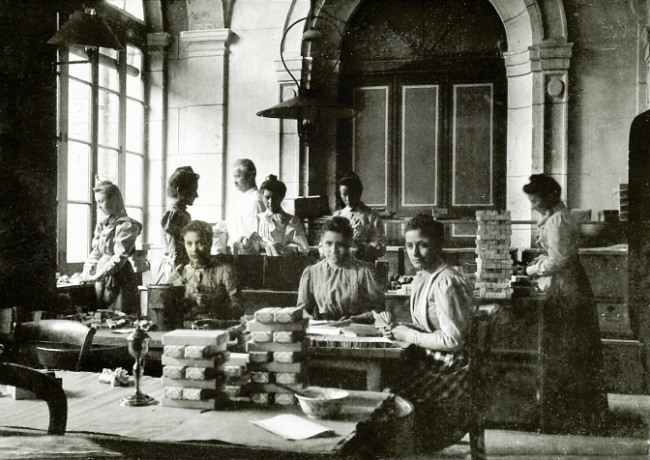
The production process in 1930 ©Anis de Flavigny
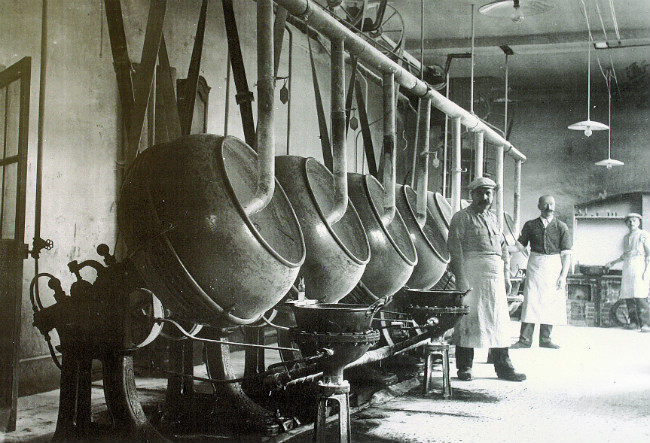
coating bonbons in the factory, 1930. ©Anis de Flavigny
A Question of Taste
Anis de Flavigny comes in ten flavours: anise, of course, but also blackcurrant, lemon, orange blossom, ginger, tangerine, mint, liquorice, rose and violet. In addition, there’s an organic range using ‘bio’ sugar. All of the varieties are made without preservatives, artificial colours or flavourings. Traditional methods sometimes involve going ‘the long way round’ – for instance, it takes two tons of rose petals to make a single litre of natural essence.
I’m sampling the different varieties of Anis de Flavigny as I write. Because the flavours are all natural there’s a pleasing subtlety to the range. For aficionados there’s nothing to beat the distinctive bitter-sweet and punchy taste of the original aniseed, while for others with a slightly sweeter tooth, there’s plenty of choice. Apparently, Agatha Christie had a penchant for the violet flavour. I’m growing fond of the lemon. You can suck on these little jewels for about five minutes before you reach the tiny grain of anise under the sugar. Could these sweets help you concentrate, I ponder… more research is needed!
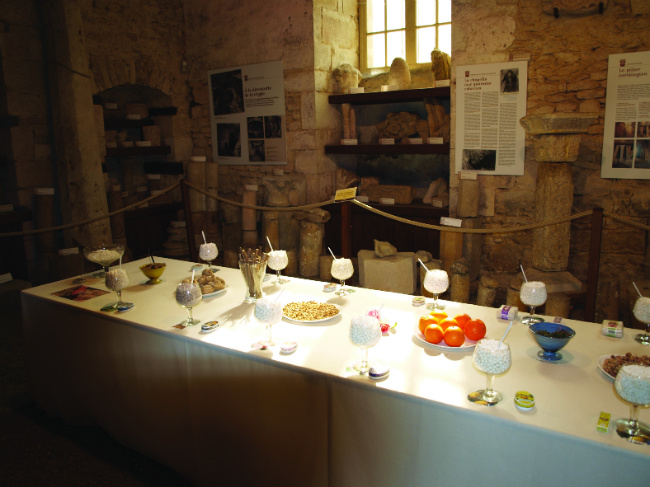
Tasting Anis de Flavigny surrounded by relics from the Abbey. Photo: Guy Hibbert
I went on to ask Catherine why people still like Anis de Flavigny. “It’s a simple and honest product,“ she said. “In a world with so much choice and so many fatty confections, people like the clean taste and the traditional box, which you can take with you to work or in the car… for some it’s a reminder of their childhood bonbons.”
The connection with nostalgia can be seen with a range of ‘collector’s tin’ editions, which feature early graphics. With portability in mind, the company has recently introduced smaller pocket boxes and also Les Petit Anis, tiny sweets the size of rice grains.
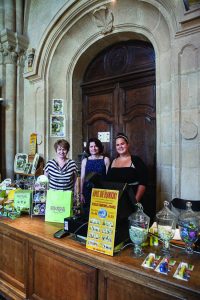
Rose, Nathalie and Lucile in the boutique ©Claire Jachymiak
About 15 years ago Flavigny became momentarily famous for another reason. It was here that Lasse Hallström chose to set his deliciously sentimental movie, Chocolat, which starred Juliette Binoche. Although there’s never been an actual chocolaterie in the village to visit, this didn’t put off the movie buffs and tourists, and the associated celebrity status gave the village a new-found fame. Talking to villagers about the experience reveals how uncertain they were at the time, of the film production taking over the streets and how the story – Binoche’s character’s sinful and indulgent chocolates eventually win over the rather puritanical locals – might have a negative impact on the community, especially in a strongly Catholic area. However, as the production unfolded, it became clear that – for many residents – there was a growing sense of community spirit, a re-discovered pride and an appreciation of some of the old traditions which have served villages like this over the centuries.
Although the excitement over Chocolat has worn off a little, as you meander through the network of medieval streets which adorn this beautiful village, and talk to the owners and workers at the unique Anis de Flavigny factory, you can start to imagine that there’s some special recipe for a peaceful and harmonious life to be found in a place like this.
It’s not so surprising, then, that some visitors return year after year; the archaeologist Guggenheim formed a strong bond with the Troubat family and often travelled back with his family, decade after decade, and there’s still a seminary in Flavigny offering spiritual retreats. Perhaps this is the other secret ingredient that makes Anis de Flavigny both commercially successful and appealing as a brand.
Despite their international ambitions, to this day, Catherine and her loyal team remain intrinsic to village life, fiercely independent, proud of their heritage and tradition, determined to do things the right way and to keep making “un bien bon bonbon”.
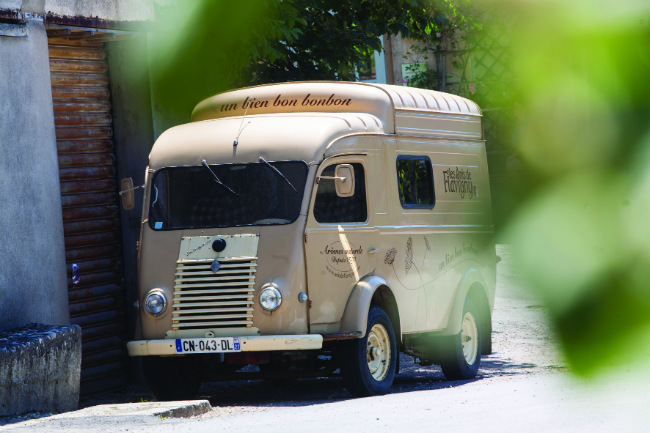
One of the Renault delivery vans, with the phrase “un bien bon bonbon” @Anis de Flavigny
Facts & Figures
Production: 220 tons of bonbons per year
Turnover: €4 million
Export: 30 per cent
Employees: 30
Visitors: Around 80,000 per year arrive to enjoy a tour and stock up on their favourite confection. The Anis de Flavigny factory has been named a Site Remarquable du Goût (Site of Remarkable Flavour) by the Ministères de l’Agriculture, de la Culture, du Tourisme et de l’Environnement.
From France Today magazine
Share to: Facebook Twitter LinkedIn Email
By Guy Hibbert
Leave a reply
Your email address will not be published. Required fields are marked *



